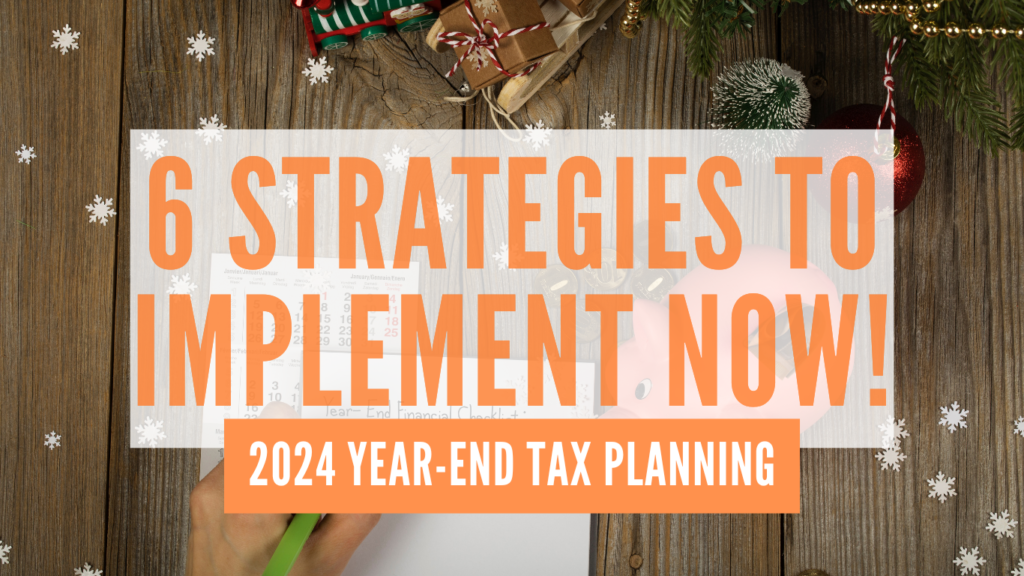The clock is ticking 2025 is almost here, and now’s the perfect time to take action to reduce your tax bill! Year-end tax planning can make a huge difference in how much you pay in taxes, and the sooner you start, the better. Whether you’re an individual taxpayer or a business owner, there are simple strategies you can implement right now to save on your taxes. Here are six key tactics to consider before 2025 arrives!
1️⃣ Max Out Retirement Contributions
One of the most powerful ways to reduce your taxable income for 2023 is by contributing to retirement accounts. Contributing to accounts like your 401(k), traditional IRA, or SEP IRA can lower your taxable income, potentially putting you in a lower tax bracket. The IRS allows you to contribute up to $22,500 to your 401(k) in 2023 (plus an additional $7,500 in catch-up contributions if you’re over 50). If you haven’t reached the limit yet, now’s the time to boost your contributions before the year ends!
Pro Tip: For IRAs, contributions must be made by the tax filing deadline (typically April 15), but for 401(k)s, the deadline is usually December 31.
2️⃣ Tax-Loss Harvesting
If you’ve got investments that have lost value, tax-loss harvesting could be a great way to offset some of your taxable gains. This strategy involves selling underperforming investments to realize the loss, which can then be used to offset taxable income, including capital gains. If you’ve realized all your gains for the year, you can use these losses to reduce other types of income, like wages, up to $3,000.
Pro Tip: Be mindful of the “wash-sale” rule, which disallows claiming a loss if you purchase the same or substantially identical security within 30 days before or after the sale.
3️⃣ Make Charitable Donations
Donating to qualified charitable organizations is a fantastic way to lower your tax bill while giving back to causes you care about. You can deduct cash donations, as well as the fair market value of donated property like clothing, cars, or even stocks. If you’re 70½ or older, you can also make a qualified charitable distribution (QCD) directly from your IRA, which counts toward your required minimum distribution (RMD) without increasing your taxable income.
Pro Tip: To maximize your deductions, keep records of your donations, including receipts and documentation of the value of any non-cash gifts.
4️⃣ Check Your Tax Withholdings
If you’ve had major life changes in 2023 (like getting married, having a baby, or changing jobs), now’s the time to review your tax withholdings. Use the IRS’s online withholding calculator to make sure you’re withholding the right amount from your paycheck. Adjusting your W-4 now can help prevent a large tax bill or a hefty refund next year.
Pro Tip: If you’ve received a large tax refund in the past, it might be time to adjust your withholding so that more of your money stays in your pocket throughout the year, rather than overpaying.
5️⃣ Pay Deductible Expenses Early
Certain expenses, like medical costs or property taxes, may be deductible for 2023. If you can pay these expenses before December 31, you may be able to claim them as deductions for the current tax year. This can help you reduce your taxable income and increase your potential refund.
Pro Tip: Consider paying for any upcoming medical treatments or buying necessary medical equipment that you know you’ll need in the new year—this will allow you to claim the expense in the current year.
6️⃣ Bunch Your Deductions
If you’re close to the standard deduction limit and don’t normally itemize your deductions, consider bunching your deductible expenses into one year. For example, you can accelerate or delay certain deductions like medical expenses, property taxes, or charitable donations to maximize your deductions in one year. This strategy can help you exceed the standard deduction threshold, allowing you to benefit from itemizing in one year, then take the standard deduction the next.
Pro Tip: Bunching works best for ongoing expenses that can be moved from one year to the next, so plan ahead for larger deductions like charitable contributions or elective medical treatments.
Don’t Wait, Start Planning Now to Save Big Later! 💰
The end of the year is the best time to get ahead of your tax planning. These strategies can help you lower your tax liability and potentially increase your tax refund. Whether you need help figuring out your contribution limits or deciding whether tax-loss harvesting is right for you, we’re here to assist you in maximizing your savings!
Need help with tax planning? DM us now! Let’s make sure you’re ready for a successful 2024.

